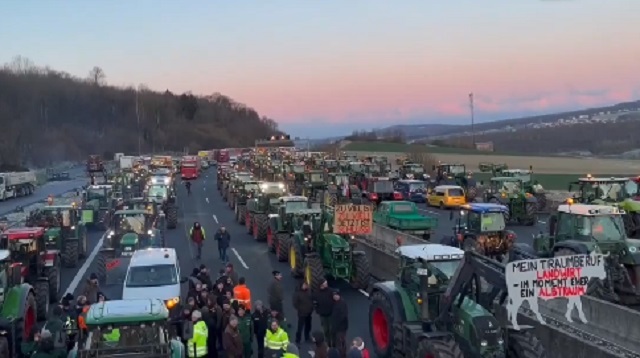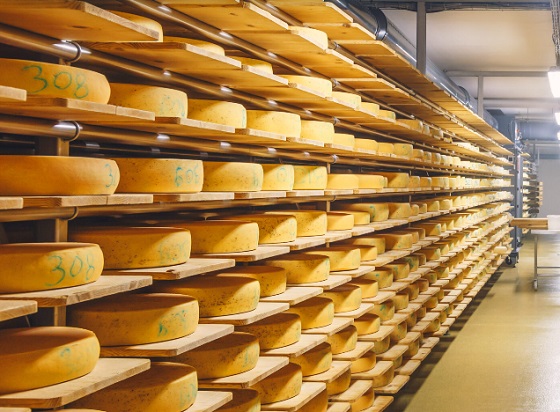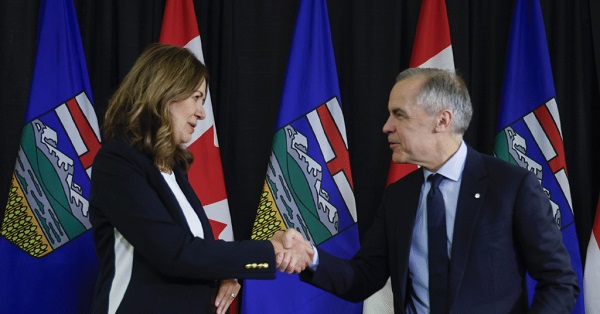Agriculture
Why Are Governments Attacking Farmers?

To approach the massive protests in Germany, especially for those who’ve heard very little about this massive upheaval, it might help to set up the context.
2024 is already proving to be a year of disruption and protest. 64 countries representing half of all people on the planet will be voting in national elections. Major elections will take place not just in the United States, but in the European Union, Russia, and in the world’s most populous democracy India.
Those conversations you’ve been having with only your most trusted cohorts, where you wonder how former friends and people you admire have become ideological combatants; are taking place all around the globe. We find ourselves identifying more and more people as either “far left” or “far right”. Even though we haven’t changed the way we think, we find we’ve also been identified by others as slipping into one of these “far” groups. Our sense of community and family are suffering and may not survive.
Why is this happening?
It comes down to where we choose to get information.
If you haven’t moved away from the legacy media yet, you’re far more likely to be disturbed by the growing numbers on the “far right”. You simply can’t understand how so many people you know have fallen victim to conspiracy theories and populist leaders who are trying to take the reigns of power.
If you have moved on to learn about the world through long form podcasts and some of the many new information platforms that have emerged, you’ll most likely be swayed by reams of information ignored by legacy media.
For tens of millions this started with the pandemic. A few months into 2020, podcasters and information sites began to notice that the average age of those dying from covid was older than normal life expectancy, that 86% of those who died were obese, that doctors around the world were successfully treating covid with cheap, repurposed drugs, and that masking, social distancing, lockdowns, and eventually covid vaccines made almost no impact on the spread of covid.
People in this camp tried to persuade those close to them that covid wasn’t as dangerous as they were lead to believe. Many conversations became emotional and annoying. One one side, raised voices of those desperate to share information. On the other side, perfectly intelligent people, informed by legacy media who had heard none of these things. Often they were told the opposite. A great example is how legacy media labelled one of the safest, cheapest and most effective drugs in world history (the developers won the Nobel Prize for inventing ivermectin) as ‘horse de-wormer’.
New media and long form podcasters have found the situation surrounding covid is the same for most other urgent situations. The inflation an energy crisis, the Russian attack of Ukraine, global warming (or climate change) and open border policies have only widened the information gap.
One side sees little reason to slow the movement of millions, or to slow the printing of money by governments unconcerned about sinking much, much further into debt. For this group the most important battles in the world are the fight to reduce carbon emissions and the war against Russia.
The other side sees a self inflicted inflation and energy crisis, a refusal to negotiate an end to the war in Ukraine, and a massive influx of immigrants beginning to cause societal upheaval.
As elections creep closer, the information gap is growing and the stakes are getting higher.
What does all this disruption and disunity have to do with massive demonstrations by German farmers? If you are a legacy media follower there is no connection. Legacy media outlets explain away this nation wide protest as farmers fighting against diesel fuel subsidies. By now, you should at least want to know what the podcasters and new media are reporting. Jordan Peterson is in that camp.
Last week, the world famous Canadian podcaster spoke with German farmer Anthony Lee and journalist Eva Vlaardingerbroek.
Eva Vlaardingerbroek is a Dutch journalist and Anthony Lee has become outspoken in recent months as he followed news of farmers struggling all across Europe. In the following videos (especially the longer one) the cause of these massive and spreading demonstrations will be explained by Eva, a new information reporter, and Anthony, a German farmer.
First a shorter video and for those with some more time their entire 100 minute long conversation.
From the YouTube channel of Jordan Peterson
A longer discussion on the ongoing farmers’ protest, the war on efficient agriculture, and net-zero goals creating excess electric vehicles while cutting off the generation of power.
This episode was recorded on January 15th, 2023
Dr. Peterson’s extensive catalog is available now on DailyWire+: https://bit.ly/3KrWbS8
Agriculture
End Supply Management—For the Sake of Canadian Consumers

This is a special preview article from the:
U.S. President Donald Trump’s trade policy is often chaotic and punitive. But on one point, he is right: Canada’s agricultural supply management system has to go. Not because it is unfair to the United States, though it clearly is, but because it punishes Canadians. Supply management is a government-enforced price-fixing scheme that limits consumer choice, inflates grocery bills, wastes food, and shields a small, politically powerful group of producers from competition—at the direct expense of millions of households.
And yet Ottawa continues to support this socialist shakedown. Last week, Prime Minister Mark Carney told reporters supply management was “not on the table” in negotiations for a renewed United States-Mexico-Canada Trade Agreement, despite U.S. negotiators citing it as a roadblock to a new deal.
Supply management relies on a web of production quotas, fixed farmgate prices, strict import limits, and punitive tariffs that can approach 300 percent. Bureaucrats decide how much milk, chicken, eggs, and poultry Canadians farmers produce and which farmers can produce how much. When officials misjudge demand—as they recently did with chicken and eggs—farmers are legally barred from responding. The result is predictable: shortages, soaring prices, and frustrated consumers staring at emptier shelves and higher bills.
This is not a theoretical problem. Canada’s most recent chicken production cycle, ending in May 2025, produced one of the worst supply shortfalls in decades. Demand rose unexpectedly, but quotas froze supply in place. Canadian farmers could not increase production. Instead, consumers paid more for scarce domestic poultry while last-minute imports filled the gap at premium prices. Eggs followed a similar pattern, with shortages triggering a convoluted “allocation” system that opened the door to massive foreign imports rather than empowering Canadian farmers to respond.
Over a century of global experience has shown that central economic planning fails. Governments are simply not good at “matching” supply with demand. There is no reason to believe Ottawa’s attempts to manage a handful of food categories should fare any better. And yet supply management persists, even as its costs mount.
Those costs fall squarely on consumers. According to a Fraser Institute estimate, supply management adds roughly $375 a year to the average Canadian household’s grocery bill. Because lower-income families spend a much higher proportion of their income on food, the burden falls most heavily on them.
The system also strangles consumer choice. European countries produce thousands of varieties of high-quality cheeses at prices far below what Canadians pay for largely industrial domestic products. But our import quotas are tiny, and anything above them is hit with tariffs exceeding 245 percent. As a result, imported cheeses can cost $60 per kilogram or more in Canadian grocery stores. In Switzerland, one of the world’s most eye-poppingly expensive countries, where a thimble-sized coffee will set you back $9, premium cheeses are barely half the price you’ll find at Loblaw or Safeway.
Canada’s supply-managed farmers defend their monopoly by insisting it provides a “fair return” for famers, guarantees Canadians have access to “homegrown food” and assures the “right amount of food is produced to meet Canadian needs.” Is there a shred of evidence Canadians are being denied the “right amount” of bread, tuna, asparagus or applesauce? Of course not; the market readily supplies all these and many thousands of other non-supply-managed foods.
Like all price-fixing systems, Canada’s supply management provides only the illusion of stability and security. We’ve seen above what happens when production falls short. But perversely, if a farmer manages to get more milk out of his cows than his quota, there’s no reward: the excess must be
dumped. Last year alone, enough milk was discarded to feed 4.2 million people.
Over time, supply management has become less about farming and more about quota ownership. Artificial scarcity has turned quotas into highly valuable assets, locking out young farmers and rewarding incumbents.
Why does such a dysfunctional system persist? The answer is politics. Supply management is of outsized importance in Quebec, where producers hold a disproportionate share of quotas and are numerous enough to swing election results in key ridings. Federal parties of all stripes have learned the cost of crossing this lobby. That political cowardice now collides with reality. The USMCA is heading toward mandatory renegotiation, and supply management is squarely in Washington’s sights. Canada depends on tariff-free access to the U.S. market for hundreds of billions of dollars in exports. Trading away a deeply-flawed system to secure that access would make economic sense.
Instead, Ottawa has doubled down. Not just with Carney’s remarks last week but with Bill C-202, which makes it illegal for Canadian ministers to reduce tariffs or expand quotas on supply-managed goods in future trade talks. Formally signalling that Canada’s negotiating position is hostage to a tiny domestic lobby group is reckless, and weakens Canada’s hand before talks even begin.
Food prices continue to rise faster than inflation. Forecasts suggest the average family will spend $1,000 more on groceries next year alone. Supply management is not the only cause, but it remains a major one. Ending it would lower prices, expand choice, reduce waste, and reward entrepreneurial farmers willing to compete.
If Donald Trump can succeed in forcing supply management onto the negotiating table, he will be doing Canadian consumers—and Canadian agriculture—a favour our own political class has long refused to deliver.
The original, full-length version of this article was recently published in C2C Journal. Gwyn Morgan is a retired business leader who was a director of five global corporations.
Agriculture
Supply Management Is Making Your Christmas Dinner More Expensive

From the Frontier Centre for Public Policy
By Conrad Eder
The food may be festive, but the price tag isn’t, and supply management is to blame
With Christmas around the corner, Canadians will be heading to the grocery store to pick up the essentials for a tasty Christmas feast. Milk and eggs to make dinner rolls, butter for creamy mashed potatoes, an assortment of cheeses as an appetizer, and, of course, the Christmas turkey.
All delicious. All essential. And all more expensive than they need to be because of a longstanding government policy. It’s called supply management.
Consider what a family might purchase when hosting Christmas dinner. Two cartons of eggs, two cartons of milk, a couple of blocks of cheese, a few sticks of butter, and an eight-kilogram turkey. According to Agriculture and Agri-Food Canada and Statistics Canada, that basket of goods costs a little less than $80.
Using price premiums calculated in a 2015 University of Manitoba study, Canada’s supply management system is responsible for $16.69 to $20.48 of the cost of that Christmas dinner. That’s a 21 to 26 per cent premium Canadian consumers pay on those five staples alone. Planning on making a yogurt dip or serving ice cream with dessert? Those extra costs continue to climb.
Canadians pay these premiums for poultry, dairy and eggs because of how Canada’s supply management system works. Farmers must obtain government-issued production quotas that dictate how much they’re allowed to produce. Prices are set by government bodies rather than in an open market. High tariffs block imports and restrict competition from international producers.
The costs of supply management are significant, amounting to billions of dollars every year, yet they are largely hidden, spread across millions of households’ grocery bills. Meanwhile, the benefits flow to a small number of quota-holding farmers. Their quotas are worth millions of dollars and help ensure profitable returns.
These farmers have every incentive to lobby, organize and defend the current system. Wanting special protection is one thing. Actually being given it is another. It is the responsibility of elected officials to resist such demands. Elected to represent all Canadians, politicians should unapologetically prioritize the public interest over any special interests.
Yet in June 2025, Parliament did the opposite. Rather than solve a problem that costs Canadians billions each year, members of Parliament from every party, Liberal, Conservative, Bloc, NDP and Green, unanimously approved Bill C-202, further entrenching the system that makes grocery bills more expensive at a time when families can least afford it. Bill C-202 prohibits Canada from offering any further market access concessions on supply-managed sectors in future trade negotiations.
This decision is even more disappointing when we consider what other nations have already accomplished. Australia and New Zealand demonstrate that removing supply management is not only possible but beneficial.
Australia operated a dairy quota system for decades before abolishing it in 2000. New Zealand began dismantling its dairy supply management regime in 1984 and completed the process in 2001. Both countries found that competitive markets provided their citizens with the access to goods they needed without the hidden costs. If these countries could eliminate supply management, so can Canada.
As the government scrambles to combat the rising cost of living, one of the simplest and most effective solutions continues to be ignored. Eliminating supply management. Removing the quotas, the price controls and the tariffs would allow market competition to do what it does across every other product category. It delivers choice, quality and affordability.
As Canadians gather for Christmas dinner, the feast may be delicious, but it will once again be more expensive than it needs to be. That is the cost of supply management, and Canadians should no longer have to bear it.
Conrad Eder is a policy analyst at the Frontier Centre for Public Policy.
-

 International23 hours ago
International23 hours agoAustralian PM booed at Bondi vigil as crowd screams “shame!”
-

 Health2 days ago
Health2 days agoFDA warns ‘breast binder’ manufacturers to stop marketing to gender-confused girls
-

 Daily Caller2 days ago
Daily Caller2 days agoTrump Reportedly Escalates Pressure On Venezuela With Another Oil Tanker Seizure
-

 Business1 day ago
Business1 day agoThere’s No Bias at CBC News, You Say? Well, OK…
-

 Uncategorized22 hours ago
Uncategorized22 hours agoMortgaging Canada’s energy future — the hidden costs of the Carney-Smith pipeline deal
-

 Opinion1 day ago
Opinion1 day agoReligion on trial: what could happen if Canada passes its new hate speech legislation
-

 International2 days ago
International2 days ago2025: The Year The Narrative Changed
-

 Automotive11 hours ago
Automotive11 hours agoCanada’s EV gamble is starting to backfire


